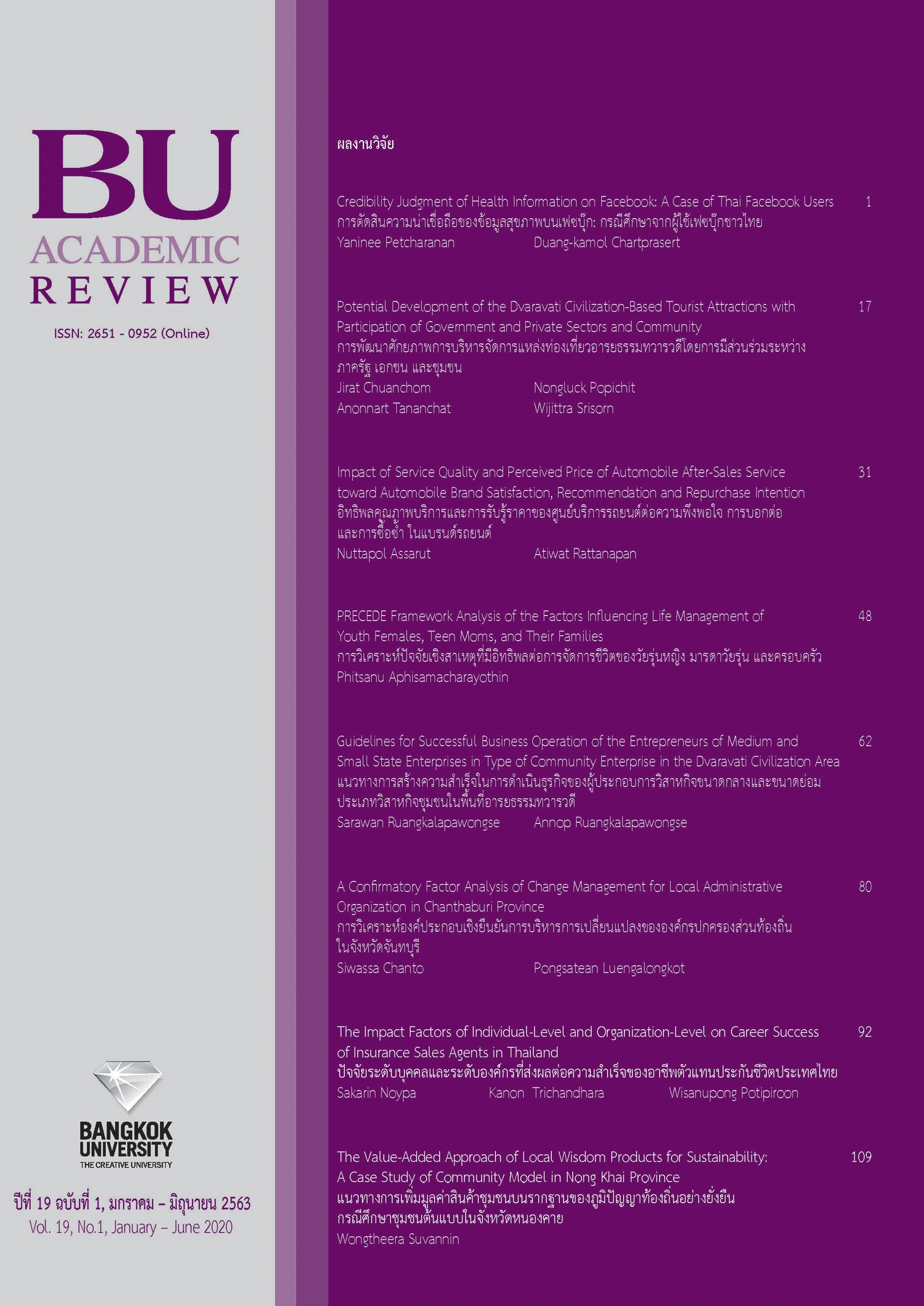Guidelines for Successful Business Operation of the Entrepreneurs of Medium and Small State Enterprises in Type of Community Enterprise in the Dvaravati Civilization Area
Main Article Content
Abstract
This research is aimed at studying the influence of organizational innovation, competitive advantage and business network towards the successful business operation of the entrepreneurs of medium and small state enterprises in type of community enterprise in the group of Dvaravati civilization area and guidelines for successful business operation. In addition, this is a mixed research with quantitative and qualitative approaches. According to the results, it was found that the organizational innovation and business network had a direct influence on competitive advantage, which, in turn, had a direct influence on successful business operation of the entrepreneurs. Furthermore, organizational innovation and business network had an indirect influence on successful business operation of the entrepreneurs through competitive advantage. In terms of plans and guidelines for successful business operation of the entrepreneurs of community enterprise in the group of Dvaravati civilization area, the operation should be carried out in 3 stages as follows: first stage: resolution plan; second stage: development plan for enhancing the community enterprises to be a strong professional entrepreneurs with competitive readiness; and third stage: sustainability plan to the community enterprises for the community to be able to continuously increase their income and have a good quality of life.
Article Details
The manuscript submitted for publication must be the original version, submitted only to this particular journal with no prior acceptance for publication elsewhere in other academic journals. The manuscript must also not violate the copyright issue by means of plagiarism.
References
Boone, L. E., & Kurtz, D. L. (2010). Contemporary Business (13th ed.). Hoboken, N.J.: Wiley
Butchiwan, P. (2016). A study of causal relationships among factors affecting innovative organizations of entrepreneurs in small and medium-sized enterprises for sustainable competitive advantages. Journal of Southern Technology, 9(2), 85-97.
Carmona-Mareno, E., Cespedes-Lorente, E. J., & De Burgos-Jimenez, J. (2004). Environmental strategies in Spanish hotels: Contextual factors and performance. Service Industries Journal, 24(3), 101-130.
Chalermglin, P., Jessadalak, V., & Ouncharoen, N. (2016). The causal relationship and effect of network strategy capability: An empirical evidence of hotels business in Thailand. Journal of Modern Management Science, 9(2), 115-130.
Community Enterprise Promotion Division, Department of Agricultural Extension. (2019). Community enterprise information system. Retrieved June 14, 2017, from http://smce.doae.go.th/Product Category/SmceCategory.php?page_size=10&PAGE=85&province_id=71®ion_id=&hur_id=&key_word=&startPage=82&endPage=91
Healy, P., Serafeim, G., Srinivasan, S., & Yu, G. (2014). Market competition, earnings management and persistence in accounting profitability around the world. Review of Accounting Studies, 19(4), 1281-1308.
Inkhean, S. (2016). Strategies related to business success of machinery firms in Samut Prakan province. (Master’s thesis, Rajamangala University of Technology Thanyaburi).
Jaakkola, M., Moller, K., Parvinen, P., Evanschitzky, H., & Mühlbacher, H. (2010). Strategic marketing and business performance: A study in three European engineering countries. Industrial Marketing Management, 39(8), 1300-1310.
Jaikaew, A., Wingwon, B., & Phanpae, P. (2015). The integrated potential of manufacturing business strategies influencing the competitive advantage of Lanna enterprises cluster in Thailand. Journal of Management Science Chiangrai Rajabhat University, 10(2), 108-139.
Janthong, K. (2014). The influence of background, entrepreneurial orientation, and social network toward business success of Ratchaburi entrepreneurs. Journal of the Association of Researchers, 19(1), 123-134.
Johne, A. (1999). Successful market innovation, European. Journal of Innovation Management, 2, 6-11.
Kaewmanee, T., & Chiyachantana, C. (2018). The role of innovation to the success of small and medium-sized home furniture & decoration business. Journal of MCU Peace Studies, 6(2), 606-618.
Kamkrue, P., & Srikhacha, S. (2013). The planning structural equation modeling for operation potential of food’s OTOP in community enterprise. Petchaburi: Silpakorn University.
Kaplan, R. S., & Norton, D. P. (1996). Using the balanced scorecard as a strategic management system. Harvard Business Review, 74, 75-85.
Lalaeng, C., Chaiphet, C., & Uea-aree, W. (2018). Business networking development and competitive advantage of community enterprise in Chumphon province. Veridian E-Journal, Silpakorn University, 11(2), 3447-3464.
Lopez-Gamero, M. D., Molina-Azorin, J. F., & Claver-Cortes, E. (2011). The relationship between manager’s environmental perceptions, environmental management and firm performance in Spanish hotels: A whole framework. International Journal of Tourism Research, 13(2), 141-163.
Murat, A., & Nilgun, A. F. S. (2013). The relationship between innovation and firm performance: An empirical evidence from Turkish automotive supplier industry. Procedia - Social and Behavioral Sciences, 75, 226 – 235.
Nakkasem, W., & Pasunon, P. (2018). Factors affecting the competitive advantage of service business entrepreneurs in Bangkok. Veridian E-Journal, Silpakorn University, 11(1), 2148-2167.
Nurul, N. A. A., & Sarminah, S. (2016). Innovation and competitive advantage: Moderating effects of firm age in foods manufacturing SMES in Malaysia. Procedia Economics and Finance, 35, 256 – 266.
Parinyasuttinun, U. (2017). Community enterprise: The paradox of the competition of business. Silpakorn University Journal, 37(2), 131-150.
Punyaruang, K., & Pooripakdee, S. (2015). Strategies competitive advantage that affect the success of the operation base on the balance scorecard concept in small and medium enterprises food processing in Supanburi province. In Proceedings of The 1st Rajabhat Nakhon Sawan Research Conference 2016 (pp. 803-816). Nakhon Sawan: Nakhon Sawan Rajabhat University.
Samuel, M. de C. (2016). Innovation as a competitive advantage issue: A cooperative study on an organic juice and wine producer. Gestão & Produção, 23(2), 397-407.
The Ministry of Industry. (2016). Thai industrial development strategy 4.0, 20 years (2017 - 2036). Bangkok: The Ministry of Industry.
The Office of the National Economic and Social Development Board. (2017). The Twelfth National Economic and Social Development Plan (2017 - 2021). Bangkok: The Office of the National Economic and Social Development Board.
The Office of Small and Medium Enterprise Promotion. (2017). SME promotion plan No.4 (2017-2021). Bangkok: The Office of Small and Medium Enterprise Promotion.
Thikom, V. (2014). Effect of networking and marketing strategy toward the success of agricultural chemicals entrepreneurs in Lampang province. In Proceeding of Rethink: Social Development for Sustainability in ASEAN Community (pp.28-34). Khon Kaen: Khon Kaen University.
Wingwon, B. (2012). Being a strategic entrepreneur. Bangkok: Ramkhamhaeng University.
Yamane, T. (1967). Statistics, An introductory analysis. New York: Harper and Row.


